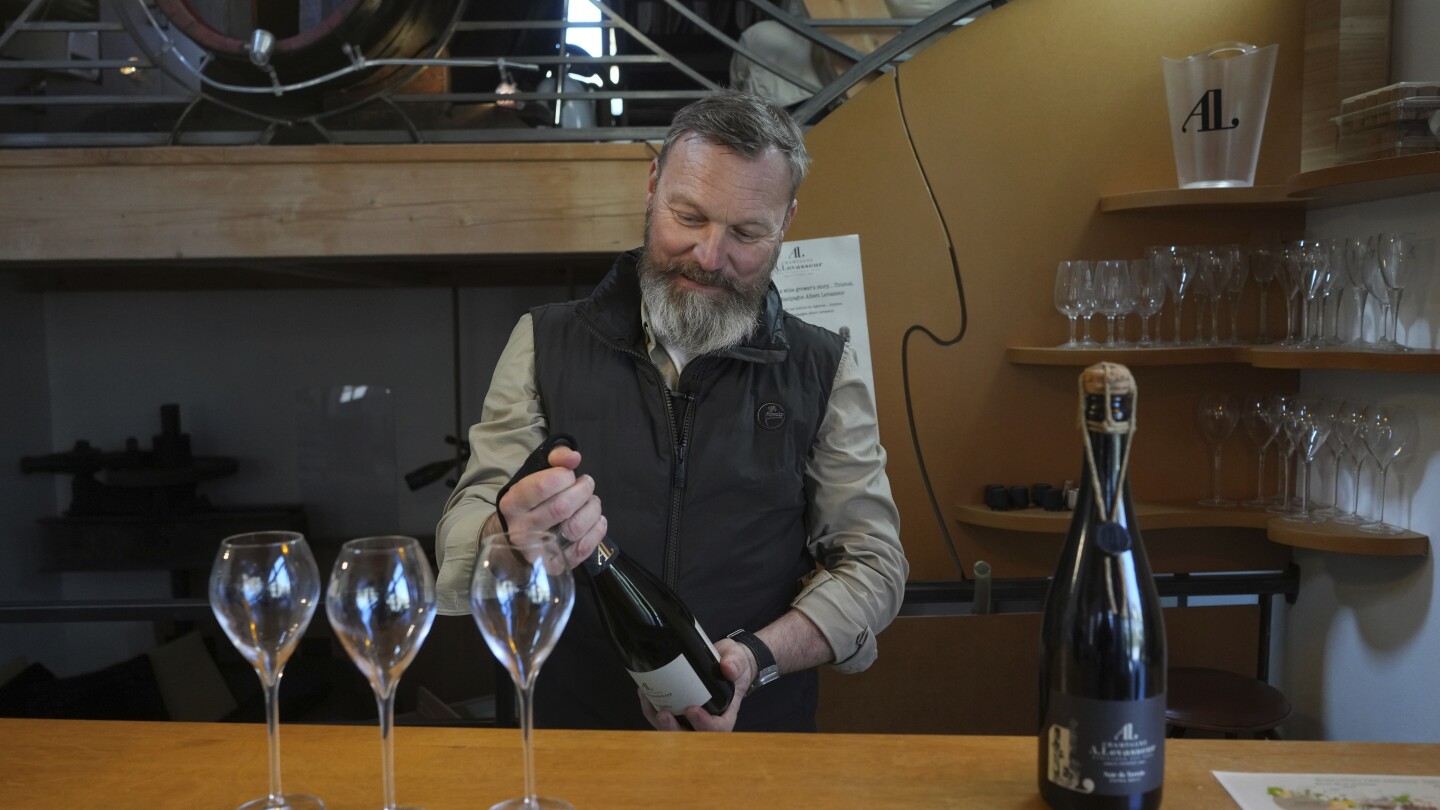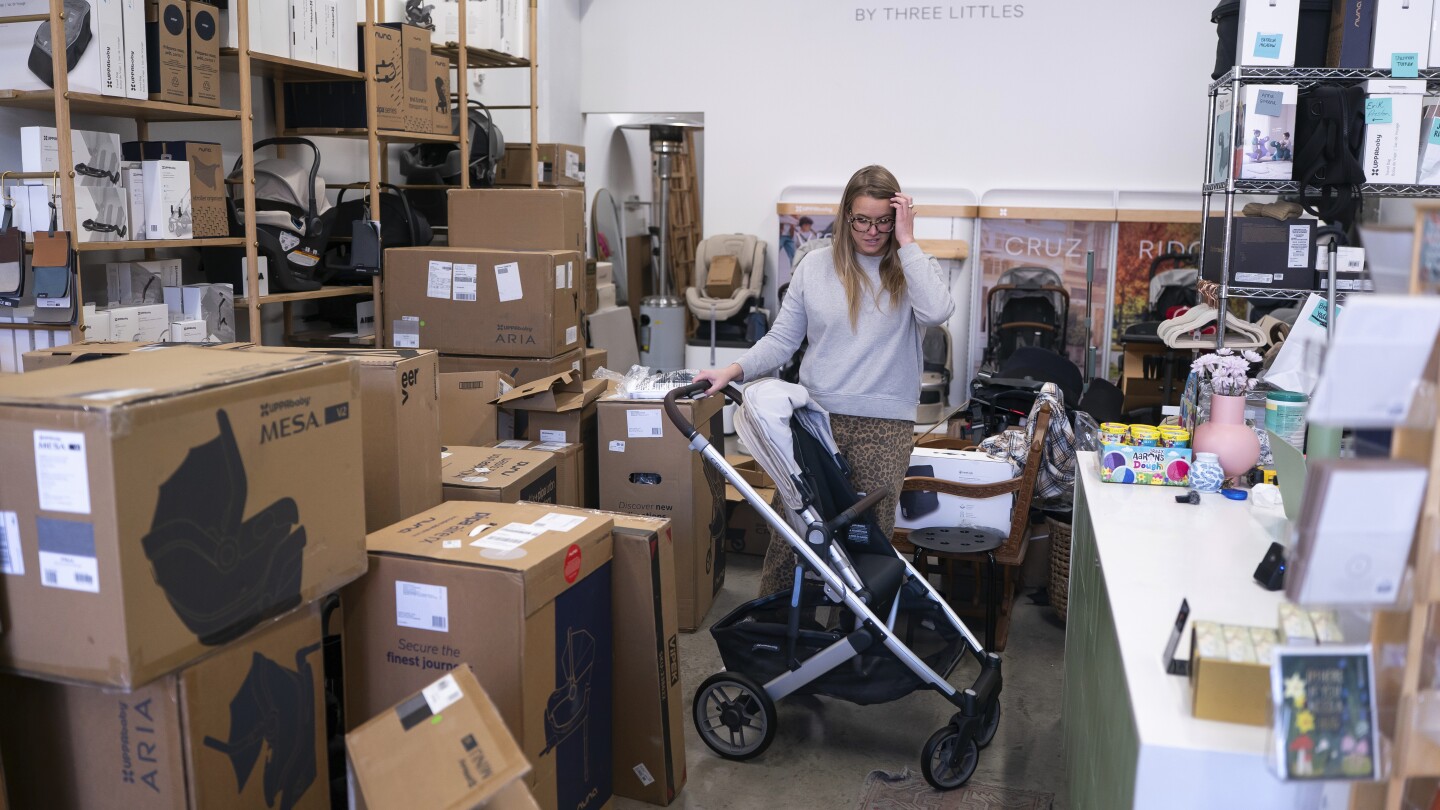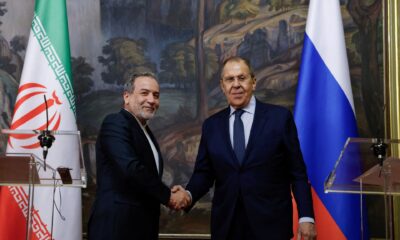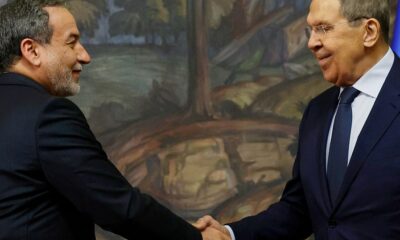Lifestyle
European wine producers brace for Trump tariffs

CHAMPAGNE, France (AP) — Across wine country in France, Italy and Spain one number is top of mind: 200%.
That’s because last week U.S. President Donald Trump threatened a tariff of that amount on European wine, Champagne and other spirits if the European Union went ahead with retaliatory tariffs on some U.S. products. The top wine producers in Europe could face crippling costs that would hit smaller wineries especially hard.
Europe’s wine industry is the latest to find itself in the crosshairs of a possible trade spat with the U.S.
Among those concerned is David Levasseur, a third-generation wine grower and owner of a Champagne house in France’s eponymous region.
“It means I’m in trouble, big trouble. We hope it’s just, as we say, blah blah,” Levasseur said, standing in his Champagne house as he swilled a flute of his vineyard’s bubbly. “When someone speaks so loudly,” he said of Trump’s 200% threat, “it’s about the media buzz. But in any case, we think there will be consequences.”
Like other wine sellers and exporters, Levasseur said that a 200% tariff on what he exports to the U.S. would essentially grind to a halt his business in that country.
“It could be a real disaster,” Levasseur said.
Italy, France and Spain are among the top five exporters of wine to the United States. Trump made his threat to Europe’s alcohol industry after the European Union announced a 50% tax on American whiskey expected to take effect on April 1. That duty was unveiled in response to the Trump administration’s tariffs on foreign steel and aluminum.
In France, a 4 billion euro market
Gabriel Picard, who heads the French Federation of Exporters of Wines and Spirits, said 200% tariffs would be “a hammer blow” for France’s industry, whose wine and spirits exports to the U.S. are worth 4 billion euros ($4.3 billion) annually.
“With 200% duties, there is no more market,” Picard said.
Still, he understood why European leaders responded to Trump’s initial tariffs.
“There’s no debate about that. We agree that Mr. Trump creates and likes to create contests of strength. We have to adapt to that,” he said.
For Italy, it’s the wine at high-end restaurants they worry most about losing
In Italy, the wine industry has called for calm, hoping that negotiators in Brussels and Washington can back down from the growing trade spat.
The U.S. is Italy’s largest wine market, with sales having tripled in value over the past 20 years. Last year, exports grew by nearly 7% to over 2 billion euros ($2.2 billion) according to Italy’s main farming lobby Coldiretti.
Strong sales at high-end restaurants, in particular, make the U.S. market difficult to replace, said Piero Mastroberardino, vice president of the national winemakers’ association Federvini.
Mastroberardino’s “Taurasi Radici” red wine, for example, was rated the fifth-best wine in the world in 2023 by Wine Spectator, an American wine and lifestyle magazine. It sells for around $80 a bottle retail in the U.S., roughly twice how much it costs in Italy, so any tariffs would push it to an “unthinkable price point,” he said.
In January, Mastroberardino’s U.S. import partners increased orders by about 20% in January anticipating possible Trump tariffs. But the increase in orders would not offset the impact of tariffs, particularly that high, he said, for long.
“It is in everyone’s interest to maintain a united front at the negotiating table,” Mastroberardino said, “especially those who are being targeted.”
Smooth reds from Spain, as well as bubbly Cava
Wine producers and industry experts in Spain, whose smooth reds are savored by tens of millions of American tourists who visit the southern European country every year, shared similar concerns about prospective tariffs.
“We don’t think they have much logic and we hope it never comes to fruition,” said Begoña Olavarría, an economic analyst at the Interprofessional Wine Organization of Spain.
Spain was the fourth-largest exporter of wine to the U.S. last year in sales, and the seventh-largest by volume, according to the trade group. Spanish wine exports to the U.S. grew by 7% last year. And the wine industry represents about 2% of the country’s overall economic output, the trade group said.
For Spain’s producers of Cava, the threat of U.S. tariffs hit especially hard. The U.S. is the largest market for the Spanish bubbly wine, which like Champagne has a designation of origin meaning it can only be made in Spain.
Mireia Pujol-Busquets is owner of the Alta Alella Bodega located in Cava country just south of Barcelona. Founded by her family in 1991, she said her business and its 40 employees immediately risk losing sales of some 25,000 bottles if the American market slams shut.
“We spent 10 years of effort opening the American market, finding distributors and building a brand,” she told the AP by phone.
While the Catalan bodega and its distributors in the U.S. were able to absorb the price increase induced by Trump’s 25% tariff on wines during his first term, Pujol-Busquets said that it is “completely irrational” to consider eating a 200% hike.
“The situation is pretty desperate,” she said.
___
Naishadham reported from Madrid. Associated Press journalists Joseph Wilson in Barcelona, Spain; John Leicester in Paris; and Colleen Barry in Milan contributed to this report.
Lifestyle
Queen Elizabeth II’s favorite dog breed race for glory in the UK’s Corgi Derby

LONDON (AP) — Some of the fastest canines on four very short legs have raced for glory in Scotland’s annual Corgi Derby.
The Musselburgh Racecourse Corgi Derby was first held in 2022 to mark Queen Elizabeth II’s 70 years on the throne. The late monarch was a devoted corgi fan who owned almost 30 of the breed over the decades, along with a few dorgis – a corgi-dachshund cross.
Four-year-old Juno beat a 16-strong field of dashing dogs dressed in bright sweaters over the 230-foot (70-meter) race on Saturday at the racecourse outside Edinburgh. She came from behind in the final stretch to beat last year’s winner, Rodney.
The winner and her owners, Alisdair Tew and Fran Brandon, were presented with a trophy and dog treats by tennis coach Judy Murray, mother of Scottish star Andy Murray.
Tew told the BBC that “we trained her for this last year but this year we just resorted to just letting her chasing things, particularly seagulls” on Edinburgh’s Portobello Beach.
“Juno is always ready for treats -– that is probably why she won,” he said.
Elizabeth’s love of corgis began in 1933 when her father, King George VI, brought home a Pembroke Welsh corgi they named Dookie
Corgis were often by Elizabeth’s side in the decades before her death in September 2022 — accompanying her on official tours, reportedly sleeping in their own room at Buckingham Palace and occasionally nipping the ankles of visitors or royal family members.
Three corgis even appeared alongside the queen as she climbed into James Bond’s waiting helicopter in the spoof video that opened the 2012 London Olympics.
Lifestyle
Tariffs are likely to make having a baby cost more

Sam Rutledge and his wife have a baby due in mid-July, so they thought they had a few more months to research and buy the gear they’ll need.
But President Donald Trump’s tariff announcement in early April turned the couple’s slow walk into a sprint. In the past few weeks, they’ve bought two strollers, a car seat, a nursery glider, a crib and a high chair. All of them are made overseas.
“These are all pretty expensive under normal conditions, but when it became clear tariffs were coming we decided to buy them in case they became prohibitively expensive,” said Rutledge, who is a high school physics teacher.
Raising a child in America has never been cheap. In the first year alone, it costs an average of $20,384, according to Baby Center, a parenting website. But tariffs – ranging from 10% for imports from most countries to 145% for imports from China — will make it many times more expensive for new parents.
An estimated 90% of the core baby care products and the parts that go into making baby paraphernalia – from bottles and diaper pails to strollers and car seats – are made in Asia, according to the Juvenile Products Manufacturers Association, a U.S. trade group. The vast majority come from China.
“Overseas manufacturing has been the norm in our industry for decades,” said Lisa Trofe, the association’s executive director.
It wasn’t always this way. When Munchkin Inc. CEO Steven Dunn founded his company in 1991, it made baby bottles in California with tooling from New Jersey. But over the years, the manufacturers he used shut down and the cost of doing business in the U.S. skyrocketed. Now, about 60% of Munchkin’s 500 products, from a $5 sippy cup to a $254 Night Owl Stroller with headlights, are made in China.
In response to the tariffs, Dunn halted orders from China and instituted a hiring freeze at Munchkin’s California headquarters, where 320 people are employed. Dunn expects Munchkin will run out of some products within three months.
“There is no possibility of being able to pass on those tariffs” to customers in the form of price increases, he said.
Dunn said he tried to reduce his dependence on China in recent years, shifting some manufacturing to Vietnam and Mexico. He also spent a year communicating with American manufacturers to see if one could make Munchkin’s new Flow Nipple Shield, which allows a breastfeeding mother to see if her milk is flowing. But most said they couldn’t make the complex silicone product, Dunn said. It’s now made in Vietnam.
“There’s not enough tool makers and manufacturing expertise and automation and skilled labor in the U.S. to make the thousands of products the juvenile industry needs,” Dunn said.
Multiple baby brands and companies contacted by The Associated Press didn’t respond or said they weren’t commenting on the tariffs, including Graco, Chicco, Britax, Nuna, Dorel Juvenile, UppaBaby, Evenflo and Bugaboo.
The Juvenile Products Manufacturers Association said it asked the Trump administration for a tariff exemption, arguing that baby products are essential for children’s well-being. Trump exempted some baby products, including car seats and high chairs, from import taxes during his first administration. But he hasn’t said whether he would consider doing so again.
The Associated Press left a message seeking comment with the White House.
Nurture&, a company that makes a popular nursery glider and other baby furniture, said it’s trying to be transparent about the impact of tariffs.
In a recent email, the company told customers it started lowering prices on some items when the tariffs hit. The company, which was founded in 2020, said it would keep those lower prices in place until April 30, but after that it may not be able to absorb the full cost of the import duties.
“These are large purchases, these are investments, and this is a very sensitive life stage,” Nurture& Chief Merchant Jill Gruys said. “We want people to make the best decision for their budget and their family.”
Elizabeth Mahon, the owner of Three Littles, a baby store in Washington, said she’s worried the tariffs will make essential products too expensive for some families.
Mahon volunteers twice per month at the Department of Motor Vehicles, where she teaches people how to buckle their kids safely into car seats. Some families still must be persuaded to use car seats, she said. Mahon fears higher prices would be another deterrent.
“No one is dying if they can’t buy a toy, but if they don’t have access to car seats, kids will get seriously injured,” she said.
At her own store, Mahon is getting notices that some manufacturers plan to introduce steep price increases in May. She feels lucky she could rent a storage facility and build up inventory ahead of the tariffs. For many small businesses, she said, the extra costs are “a death sentence.”
At The Little Seedling baby shop in Ann Arbor, Michigan, owner Molly Ging said she would normally be putting in Christmas orders at this time of year. Instead, she’s sorting through price increase notices from many of the vendors she works with.
“It’s a lot to manage, and I just have no idea how it’s going to play out,” she said.
Business is brisk right now, with customers hoping to beat tariff-related price increases. But Ging worries about her 13 employees – all moms who bring their kids to work – and about whether she can maintain enough inventory to meet future demand.
“Babies don’t stop being born because there’s tariffs,” she said.
Lifestyle
Famed Sherpa guide will attempt to climb Mount Everest for a 31st time and break his own record

KATHMANDU, Nepal (AP) — One of the greatest mountain guides will attempt to scale the world’s highest peak for the 31st time — and possibly the 32nd time as well — and break his own record.
Kami Rita, 55, flew to Mount Everest on Sunday from Kathmandu to lead a group of climbers who will try to reach the 8,849-meter (29,032-foot) summit during the spring climbing season.
“I am mentally, emotionally and physically prepared to climb the mountain,” Kami Rita told The Associated Press at Kathmandu’s airport. “I am in my top physical condition right now.”
He holds the record for the most successful ascents of Mount Everest at 30 times. In May last year he climbed the peak twice.
“My first priority is to get my client to the summit of the peak. Then I will decide on whether I will climb the peak more than one time during the season. It depends on the weather and conditions on the mountain,” he said.
His closest competitor for the most climbs of Mount Everest is fellow Sherpa guide Pasang Dawa, who has made 27 successful ascents of the mountain.
Kami Rita first climbed Everest in 1994 and has been making the trip nearly every year since. He is one of many Sherpa guides whose expertise and skills are vital to the safety and success each year of foreign climbers aspiring to stand on top of the mountain.
His father was among the first Sherpa mountain guides. In addition to his Everest climbs, Kami Rita has scaled several other peaks that are among the world’s highest, including K2, Cho Oyu, Manaslu and Lhotse.
According to Nepal’s Department of Tourism, 214 climbers have been issued permits to attempt Mount Everest from the Nepali side of the peak in the south this climbing season, which ends in May. Most climbing of Everest and nearby Himalayan peaks is done in April and May, when weather conditions are most favorable.
Everest was first climbed in 1953 by New Zealander Edmund Hillary and Nepali Sherpa Tenzing Norgay.
-

 Education2 days ago
Education2 days agoHarvard’s battle with the Trump administration is creating a thorny financial situation
-

 Sports2 days ago
Sports2 days agoClint Dempsey speaks to CNN over his concerns over the USMNT heading into its home World Cup
-

 Middle East1 day ago
Middle East1 day agoTunisian court hands opposition figures lengthy jail terms | Human Rights News
-

 Europe2 days ago
Europe2 days agoTrump’s ‘lone ranger’: How Steve Witkoff became the defacto point man on America’s foreign policy challenges
-

 Conflict Zones2 days ago
Conflict Zones2 days agoIran has ‘doubts’ about US intentions ahead of nuclear talks | Politics News
-

 Conflict Zones2 days ago
Conflict Zones2 days ago‘How do I live like this?’ asks Gaza boy who lost arms in Israeli attack | Gaza News
-

 Conflict Zones2 days ago
Conflict Zones2 days agoTrump says US may ‘pass’ on helping end war if Russia, Ukraine resist deal | Russia-Ukraine war News
-

 Africa2 days ago
Africa2 days agoIran seeks Russia’s support for its nuclear talks with US




